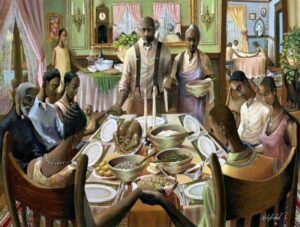By Dr. Arthur Schwartz
Right after the Forum I came across a book in my office that I meant to read a few years ago, but never did. That night I started to read the book and I couldn’t put it down. Titled Thanksgiving: The Holiday at the Heart of the American Experience by Melanie Kirkpatrick, the book completely enthralled me.
The author starts by taking us inside a public high school in the Bronx where 48% of the students were born outside the U.S. She was invited by one of the teachers to talk about the book. She writes: “These young newcomers had a very personal understanding of the earliest story at the heart of the American experience. For them, the Pilgrim story was their story, and the Pilgrim fathers and mothers were historical reflections of themselves” (emphasis in the original).
I encourage everyone to read this book. I learned so much.
Kirkpatrick recognizes that for many of us today, Thanksgiving is about the 3 F’s: Family, Feasting, and Football. But she argues that underneath the turkey, stuffing and cranberry sauce, the holiday vivifies the best of our American character.
Reflecting on her perspective, I took away 5 ways that Thanksgiving still represents the best of the American spirit:
#1 – Thanksgiving is about an “attitude of gratitude”
We live in a historical moment where cynicism in America is rampant, especially within our political discourse. But I believe we as Americans have so much to be grateful for. Norman Rockwell captured this “gratitude of abundance” during his World War II-era painting called Freedom from Want. In short, Thanksgiving is a day when every American should express our gratitude for the taproots and seedbeds that give each of us meaning and purpose.
#2 – Thanksgiving is about hospitality
We learn at a young age that the Pilgrims “welcomed” the Wampanoag Indians to their celebratory feast. But Kirkpatrick tells us that the Wampanoag’s “went out and killed five deer” which the Wampanoag chief offered to the Pilgrims. Fast forward to today: How many children and teens will hear a guest or neighbor ask: “What can I bring”? How many will be listening to their parents or caregivers discuss “Who should we invite?” Surely, Thanksgiving is a time for us to model and practice the forgotten virtue of hospitality.
#3 – Thanksgiving is about helping others
My favorite chapter in Kilpatrick’s book was titled “Helping Hands.” I sometimes forget that for many families Thanksgiving is a time to serve others (a quick shout-out to Julia Brady at the Imagine Schools for sharing with me how her family strives to serve others on Thanksgiving). Kilpatrick’s book evokes what Alexis de Tocqueville noticed about Americans during his travels to the United States in the 1830s: we help and support each other. Americans are the world’s most generous people. We established Giving Tuesday as well as efforts to combat hunger and homeliness. Mother Teresa was right when she wrote that “it’s not how much we give, but how much we put into giving.”
#4 – Thanksgiving is about prayer and “grateful hearts”
In 1789, after a Congressional Resolution, George Washington penned a Presidential Proclamation to the American people to celebrate a day of “public thanksgiving and prayer to be observed by acknowledging with grateful hearts the many signal favors of Almighty God.” This Thursday, for many families the heartbeat of Thanksgiving will still begin with prayer and devotion to God. I came across the photo below and it touched my soul, on so many levels. Thanksgiving is for many a time when families connect their “grateful hearts” to their religious faith.
#5 – Thanksgiving is about love of family (and traditions)
I love traditions, whether rooted in families, schools, sports, religions, or communities. I’m always asking students about a family ritual that means the most to them – and why. At Character.org, we encourage school leaders to create student-led traditions that foster a culture of character. Personally, I soak in the positive energy of seeing my children and nephews together on Thanksgiving. I really do believe our traditions shape who we are and what we believe.
Some people reading this post may have a mindset that sees America more for her faults and failures than for her successes and achievements. What we need, they would argue, is not a day of thanks but a day of atonement. While I respect their perspective, I’d rather stand with Sarah Josepha Hale, the “godmother” of Thanksgiving. In the mid-1800s, the long- time editor of the popular magazine Godey’s Lady’s Book used the magazine to campaign for a National Day of Thanksgiving. She wrote hundreds of letters to mayors, governors, and legislators about her idea for a day of “social rejoicings.” The Library of Congress still has the letter she wrote to Abraham Lincoln where she told the president that such a day could have a “deep moral influence” on our national character. Steadfastly, I share her belief.









0 Comments